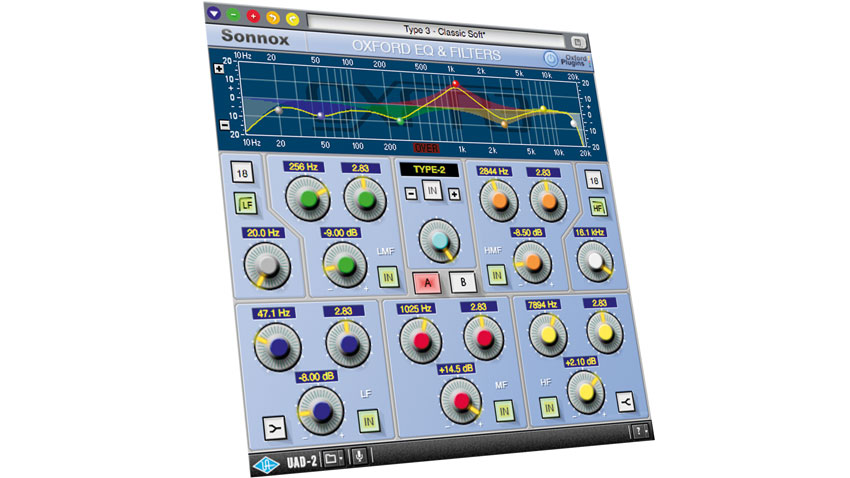MusicRadar Verdict
You must decide which platform best suits your needs for this great-sounding EQ.
Pros
- +
Four EQ 'types' suitable for a variety of applications. Great, rich sound. UAD-2 processors free up your core CPU.
Cons
- -
Expensive re-purchase for existing users.
MusicRadar's got your back
18 months ago, UAD opened up a Software Development Kit to allow existing plug-in manufacturers to port versions of its plug-ins to the UAD platform. Some observers were surprised at the move, partly as UAD's reputation has been forged on building high-quality software emulations of classic hardware, and partly because they couldn't understand why software manufacturers would want to make their plug-ins available for a rival platform.
To date, Brainworx, SPL and Sonnox have signed up to be a part of this new alliance and the first plug-in to make the successful transition is the Sonnox EQ. Perhaps 'transition' is the wrong word; after all, this plug-in continues to be available natively, direct from Sonnox themselves. So, what's in this for UAD? What's in it for Sonnox? And, most importantly, what's in it for you?
Four degrees from Oxford
Well, before we answer these questions, let's first deal with the EQ plug-in itself. For the uninitiated, the Sonnox EQ recreates the tone-shaping capabilities from the OXF-R3 digital mixing console, originally produced in the early '90s. 'Digital' EQs don't have quite the caché of their analogue-modelled equivalents but the Sonnox EQ breaks that rule, through its flexible architecture.
"Sonnox EQ has proved itself to be a fantastic-sounding, go-to processor for a range of producers and mix engineers alike"
Type 1 represents the quintessential all-purpose EQ, with bell-shaped cut/boost curves remaining constant regardless of bandwidth setting. Type 2 echoes this movement for boosts while cut curves are tighter, allowing you to focus on sharper dips while retaining smoother peaks. Type 3 keeps smooth, broad level curves when working with small amounts of cut/boost, with peaks and troughs becoming notably sharper as gain is increased.
Finally, EQ Type 4 is optimised for mastering, with softer, subtler characteristics and the tightest gain/bandwidth relationship of the four approaches. Through this flexibility, the Sonnox EQ has proved itself to be a fantastic-sounding, go-to processor for a range of producers and mix engineers alike, as it's capable of fine-tuning and radical tone-shaping in equal measure.
What's in it for you?
All of that aside, to whom will UAD-2's adoption of this plug-in appeal? If you're an existing Sonnox and UAD user, you'll have to decide if the primary appeal - the fact that you can switch CPU load from your computer to your UAD card - is sufficiently strong to buy the same plug-in again.
"If you're a UAD card holder but don't yet possess the Sonnox EQ, a purchase will certainly prove more tempting"
If you're a UAD card holder but don't yet possess the Sonnox EQ, a purchase will certainly prove more tempting, though do be aware that the $299 price tag is only marginally cheaper (after currency conversion) than buying Sonnox's original and is more expensive if you buy two or more plug-ins direct from the Sonnox site, factoring in the percentage discounts offered on multiple purchases.
Lastly, it's worth noting that the UAD platform remains at 32-bit. By the end of the year, this will have been rectified but with the Sonnox native plug-ins already 64-bit compatible, it's another consideration.
What's not in doubt is that the Sonnox EQ is a great-sounding processor, capable of doing a wonderful job through a wide range of musical applications. It's a processor we use almost daily for production and mastering and we'd thoroughly recommend it. Only you can decide if the UAD platform represents the best way to bring it to your own productions.
“I have an original 909 – every time I try to use it I feel like I’m ruining it”: House hero Riva Starr on his studio essentials and his love of analogue synths
“A synthesizer that is both easy to use and fun to play whilst maintaining a decent degree of programming depth and flexibility”: PWM Mantis review
“I feel like that song had everything we needed to come back with”: Bring Me The Horizon’s Lee Malia on Shadow Moses, its riff and the secrets behind its tone, and why it was the right anthem at the right time










